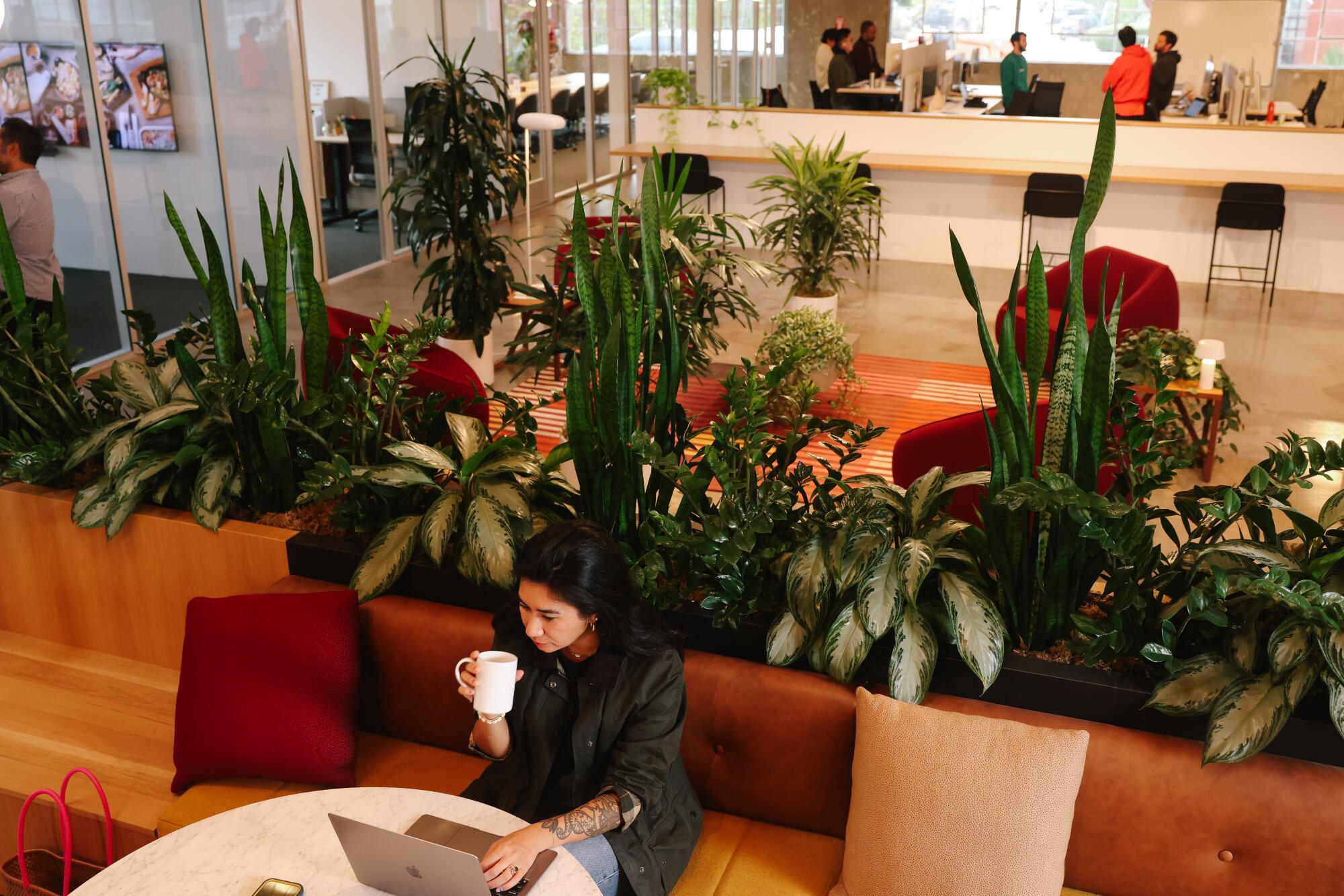
- More than four years after the pandemic scrambled work culture, friction between bosses and their employees over the terms of their return to the office shows no signs of abating.
- Many organizations have put in place return-to-office policies, but only a fraction of them actively enforce the rules, a recent survey found.
- In efforts to raise attendance, companies are experimenting with carrots and sticks, trying to make the office a more appealing place to visit while testing methods to enforce in-office policies.
Since Cynthia Clemons’ employer announced last month that she was required to be in the office two days each week, the switch from remote work hasn’t been smooth.
The self-described extrovert, who works as an organizer for the nonprofit Abundant Housing LA, said she so far hasn’t “gotten into a rhythm of being productive at a desk again.”
“I feel like I’m back in grade school and being forced to sit down and do my homework,” she said. “Maybe it’s a matter of getting used to it.”
More than four years after the COVID-19 pandemic scrambled work culture by closing offices and forcing people to work from home, friction between bosses and their employees over the terms of their return shows no signs of abating.
About 80% of organizations have put in place return-to-office policies, but in a sign that many managers are reluctant to clamp down on the flexibility employees have become accustomed to, only 17% of those organizations actively enforce their policies, according to recent research by real estate brokerage CBRE.
Work from home is what many employees want. But employers still want you back in the office
“Some organizations out there have ‘mandated’ something, but if most of your organization is not following that mandate, then there is not too much you can do to enforce it,” said Julie Whelan, head of research into workplace trends for CBRE.
So, for many employers, setting rules for how often workers must come to the office has turned into a tricky search for a Goldilocks formula that will keep both bosses and workers reasonably happy — or at least not in open conflict. Managers may yearn for the days when daily attendance was a given, but their employees have moved on to a new normal and appear to be in no mood to go back.
The tension “is due to the fact that we have changed since we all went to our separate corners and then came back” from pandemic-imposed office exile, said Elizabeth Brink, a workplace expert at architecture firm Gensler. “It’s fair to say that we have different needs now.”
A disconnect persists between employer expectations for office attendance and employee behavior, CBRE found. Sixty percent of leaders surveyed said they want their employees in the office three or more days a week, while only 51% reported that employees work in the office at that frequency.
Conversely, 37% of employees show up one or two days a week, yet only 17% of employers are satisfied with that attendance.
CBRE surveyed 225 corporate real estate executives who oversee portfolios of office buildings to analyze trends among occupants seeking to implement hybrid work models.
As employers struggle to get their employees back in person, they also are also calculating whether to shed office space to cut down on rent, typically the largest cost of operating a business after payroll. Some employers are eliminating personal desks in favor of unassigned work stations that can be occupied as needed, allowing businesses to shrink their office footprints.
Such downsizing has contributed to widespread office vacancies in some urban centers including downtown Los Angeles, where overall vacancy is more than 30%, according to CBRE.
In efforts to raise attendance, companies are experimenting with carrots and sticks, trying to make the office a more appealing place to visit while testing methods to enforce in-office policies.
L.A.’s financial district, once the thriving heart of downtown, struggles to bounce back from pandemic shutdown and homeless crisis. Experts say it needs more housing, fewer offices.
At Los Angeles financial services firm Wedbush Securities, most employees are expected to be in the office one-third of the days of the month while working remotely the rest of the time. The reduction in required time on-site has allowed the firm to cut its office footprint dramatically from more than 100,000 square feet in downtown L.A. to 20,000 square feet in an ongoing move to new quarters in Pasadena.
President Gary Wedbush is depending on supervisors “to keep their teams honest” about how often they show up at work, he said, but some compliance measures may be coming.
“There definitely needs to be some type of enforcement function,” he said, though the firm hasn’t settled on one yet. Among the options are tracking security badge swipes or checking where company laptops are plugged in during the day.
Attendance will also be “an important factor” in performance evaluations, Wedbush said. “We need to have colleagues be together to collaborate, because we definitely think that’s going to support and continue to improve our client experience. We feel very strongly about that.”
Employees at the DTLA Alliance business improvement district in downtown Los Angeles do not have to follow a formal or enforced attendance policy, Executive Vice President Nick Griffin said, but “the expectation is you should default to working in the office unless there is a good reason otherwise.”
“I personally prefer being in the office, to be close to my team and to be able to chat through things at the drop of a hat,” he said. “That’s very valuable to me.”
Flexibility is helpful to employees, though, he said. Some of Griffin’s staff work from home now and then, and he highlighted an employee with a small child who lives far from the office who is allowed to work remotely most of the time while being “among the most productive members of our team.”
“One of the things that we have found is that good employees are good employees, whether they’re in the office or remote, and mediocre employers are mediocre, whether they’re chained to their desk or not.”
The DTLA Alliance’s accommodation of the employee with a young child and a long commute reflects the challenge bosses have in meeting the desires of employees in different stages of their lives and careers as companies move past one-size-fits-all attendance policies.
Younger people may value the freedom to get their work done around going to the gym or meeting with friends, while an older employee might be juggling commuting to the office with child care or elder care, Whelan said.
“First of all, regardless of generation, from baby boomers down to Gen Z, flexibility is important,” Whelan said. “Nobody wants to be told anymore that there’s one place they need to be from eight to six, five days a week.”

Bosses, meanwhile, see value in having people of all experience levels in the office to build a corporate culture and shared sense of mission.
“The crux of this challenge is keeping people at younger stages engaged and feeling like they’re part of something bigger, and that they’re getting that knowledge-sharing and mentorship they need to really further their career,” Whelan said. “The younger generation needs the older generation to be there to pass down that knowledge.”
Being in the office can boost employees’ mental health, Brink said, especially if it has a variety of work spaces that allow staff to both collaborate and work privately.
“One of the reasons people do want to come in to the office is to connect with one another,” she said, “because it’s been really challenging for many people to be so isolated.”
Free food and drinks, comfortable furniture, and communal work tables can be draws, Brink said. Some newer offices have library-type spaces designated as quiet zones, where cellphones and conversations are not allowed.
“That can be really helpful for people who need that intense focus,” she said.
Offices will remain “a very core piece of organizational culture” in the years ahead, Whelan said, but how often employees will be required to be there is far from settled.
“I do believe that it will take a generational change in management before this story is really fully told,” she said. Future generations of leadership may decide to vary in-office requirements depending on the goals of their organizations at particular points in time.
“It will become less of a conversation of how many days of the week and more of a conversation about, are the things that I’m supposed to be accomplishing with my team together being accomplished?”
More to Read
Inside the business of entertainment
The Wide Shot brings you news, analysis and insights on everything from streaming wars to production — and what it all means for the future.
You may occasionally receive promotional content from the Los Angeles Times.













